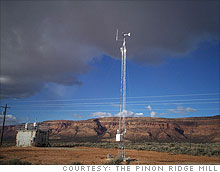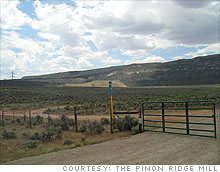In uranium we trust
For one Colorado rancher, uranium is the key to the future.
 |
| An air monitoring and met station at the site for the Piñon Ridge Mill. |
 |
| Site as viewed from the northwest. |
NEW YORK (Fortune) -- With just one more permit from the State of Colorado, Energy Fuels Resources Corporation founder and CEO George Glasier can break ground for the first new U.S. uranium mill since the Cold War.
Glasier's Piñon Ridge Mill, in Colorado's Paradox Valley, has been long in the making. EFR has spent nearly $9 million on development of the mill, with construction expected to cost another $130 million, possibly beginning in 2011.
CH2M Hill has designed the computerized mill to process up to 1,000 tons of uranium daily, five pounds of uranium to the ton. The mill's design is so environmentally friendly and technologically advanced, there's nothing like it in the world, Glasier says.
He's already talking to overseas customers: "The Chinese are acquiring uranium assets everywhere they can," he says. And here at home, he estimates that, in the country's clean energy future, electric utilities will generate enough need to boost uranium from its present $46 to a more robust $70 per pound. The Nuclear Regulatory Commission already has 22 applications for new nuclear plants nationwide; globally there are 53 new plants under construction and 436 operational.
Though this is exactly the kind of project that might normally lead neighbors to say, "Not in my back yard," there's local precedent in Paradox Valley and throughout Montrose County. Union Carbide once ran a uranium mill nearby, which the Environmental Protection Agency later made one of its Superfund sites, spending $120 million to clean up hazardous materials there.
Montrose County also supplied uranium for Madame Curie, the Manhattan Project, and Little Boy and Fat Man, the two bombs dropped on Hiroshima and Nagasaki, says local geologist Mike Thompson.
It's definitely an area with a past.
What's more, though Glasier is now a gentleman rancher, in his former life -- which included a series of uranium industry corporate counsel gigs in Denver -- he helped acquire properties for the White Mesa Mill in Utah, the last U.S. uranium mill constructed and the only mill currently operating.
Then, 17 years ago, he left it all to build a herd of 1,000 Black Angus alongside western Colorado's San Miguel River, an area of flat valleys and red sandstone cliffs 60 miles northwest of Telluride and two hours from the nearest Wal-Mart.
Which means, today, he's actually building this mill in his own community.
With the door already open, Glasier has courted his community by speaking to business groups, holding a barbecue with live music in a local park, and giving tours of the blank building site. When the county awarded Glasier a land use permit in September, it was viewed as a vote of local confidence.
"I'm considered a local," he says. He has served on the irrigation ditch company board, as town attorney (pro bono) for the 1,400-population Naturita (which has returned the favor by granting him back-up water rights for the proposed mill), and "helped put together a pretty good application for a job corps center."
But jobs are elusive. With a 7.3% unemployment rate, nearly 1,000 county residents are out of work.
"In a small town, you know them all," says Terri Tooker, Naturita Chamber of Commerce president. "The area certainly needs an economic boost."
State economist Alexandra Hall agrees. But she also marvels at recent developments: "Our country has been through periods when it's been completely taboo to talk about adding nuclear power plants."
The mill is expected to provide 85 jobs, and 200 more are likely to come from its mines. Calculating ripple effect, the Western Small Miners Association hopes for 1,392 new jobs total, from housing construction to schools.
Many of Glasier's neighbors will likely be his employees, and nearly everyone has past ties to uranium. In 2008, Montrose County mineworkers averaged $55,927 annual pay, but local bloggers -- some the children of deceased uranium miners -- have alluded to the tradeoff of adequate income versus shortened lives. (Uranium workers here have had a cancer rate that's estimated to be five times higher than average.)
There have been high-profile opposition efforts: Actress Daryl Hannah showed up at a hearing to denounce the proposed mill. And one anti-mill website lists 21 opposed organizations, including Sierra Club, Earth Justice, and Uranium Watch.
But Colorado Governor Bill Ritter (D) says he believes a new mill can be safe, U.S. Senator Mark Udall (D-Co.) promises hawk-like vigilance, and Colorado's Department of Public Health and Environment anticipates taking 14 careful months to review EFR's mill application.
The White House defers comment to the Department of Energy, which says, through spokesperson Jennifer Lee, "Unlike the first half of the 20th century, several federal and state agencies are actively involved in protecting uranium mill and mine workers and the public from potential harm: the EPA, NRC, NRC Agreement States, the Department of Labor Mines Safety and Health Administration, and the DOE."
Many local residents, like Tomcat Mine owner John Reams, hope the permitting process moves quickly. Reams laid off 20 uranium miners from his Montrose County mine last month because Utah's White Mesa Mill stopped buying ore. So he welcomes the new mill. But he initially questioned if others would: "At first, we were wondering. We know the people doing it, but it was quite an obstacle to mount, to get the local people and get through the county."
Glasier acknowledges a debt to his neighbors for trusting him this far, and he says they won't be sorry. "There's a 95% chance we'll get the license and build the mill," he says. "Credit's available; we have mines ready to go into production."
Noting that the U.S. is the world's largest uranium consumer, while Russia is the main supplier, Glasier adds, "We've got to start producing uranium again." ![]()
-
 The retail giant tops the Fortune 500 for the second year in a row. Who else made the list? More
The retail giant tops the Fortune 500 for the second year in a row. Who else made the list? More -
 This group of companies is all about social networking to connect with their customers. More
This group of companies is all about social networking to connect with their customers. More -
 The fight over the cholesterol medication is keeping a generic version from hitting the market. More
The fight over the cholesterol medication is keeping a generic version from hitting the market. More -
 Bin Laden may be dead, but the terrorist group he led doesn't need his money. More
Bin Laden may be dead, but the terrorist group he led doesn't need his money. More -
 U.S. real estate might be a mess, but in other parts of the world, home prices are jumping. More
U.S. real estate might be a mess, but in other parts of the world, home prices are jumping. More -
 Libya's output is a fraction of global production, but it's crucial to the nation's economy. More
Libya's output is a fraction of global production, but it's crucial to the nation's economy. More -
 Once rates start to rise, things could get ugly fast for our neighbors to the north. More
Once rates start to rise, things could get ugly fast for our neighbors to the north. More







